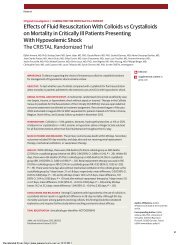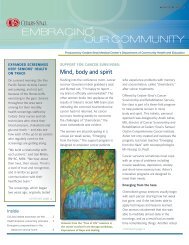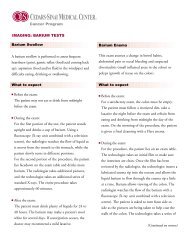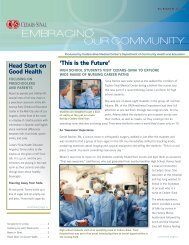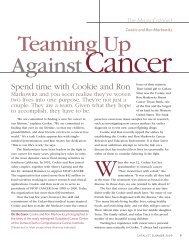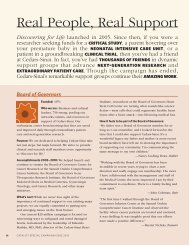Life after near death: Long-term outcomes of ... - Cedars-Sinai
Life after near death: Long-term outcomes of ... - Cedars-Sinai
Life after near death: Long-term outcomes of ... - Cedars-Sinai
You also want an ePaper? Increase the reach of your titles
YUMPU automatically turns print PDFs into web optimized ePapers that Google loves.
ORIGINAL ARTICLE<br />
<strong>Life</strong> <strong>after</strong> <strong>near</strong> <strong>death</strong>: <strong>Long</strong>-<strong>term</strong> <strong>outcomes</strong> <strong>of</strong> emergency<br />
department thoracotomy survivors<br />
Deborah Keller, MS, MD, Heather Kulp, RN, MSN, Zoe Maher, MD, Thomas A. Santora, MD,<br />
Amy J. Goldberg, MD, and Mark J. Seamon, MD, Camden, New Jersey<br />
BACKGROUND:<br />
METHODS:<br />
RESULTS:<br />
CONCLUSION:<br />
LEVEL OF EVIDENCE:<br />
KEY WORDS:<br />
Predictors <strong>of</strong> hospital survival <strong>after</strong> emergency department thoracotomy (EDT) are well established, but little is known <strong>of</strong><br />
long-<strong>term</strong> <strong>outcomes</strong> <strong>after</strong> hospital survival. Our primary study objective was to analyze the long-<strong>term</strong> social, cognitive,<br />
functional, and psychological <strong>outcomes</strong> in EDT survivors.<br />
Review <strong>of</strong> our Level I trauma center registry (2000Y2010) revealed that 37 <strong>of</strong> 448 patients survived hospitalization <strong>after</strong><br />
EDT. Demographics and clinical characteristics were analyzed. After attempts to contact survivors, 21 patients or caretakers<br />
were invited to an outpatient study evaluation; 16 were unreachable (none <strong>of</strong> whom were present in the Social Security Death<br />
Index). Study evaluation included demographic and social data and an outpatient multidisciplinary assessment with validated<br />
scoring instruments (Mini-Mental Status Exam, Glasgow Outcome Scores, Timed Get-Up and Go Test, Functional Independence<br />
Measure Scoring, SF-36 Health Survey, and civilian posttraumatic stress disorder checklist).<br />
After extended hospitalization (43 T 41 days), disposition varied (home, 62%; rehabilitation, 32%; skilled nursing facility,<br />
6%), but readmission was common (33%) in the 37 EDT hospital survivors. Of the 21 contacted, 16 completed the study<br />
evaluation, 2 had died, 1 remained in a comatose state, and 2 were available by telephone only. While unemployment (75%),<br />
daily alcohol (50%), and drug use (38%) were common, <strong>of</strong> the 16 patients who underwent the comprehensive, multidisciplinary<br />
outpatient assessment <strong>after</strong> a median <strong>of</strong> 59 months following EDT, 75% had normal cognition and returned to normal activities,<br />
81% were freely mobile and functional, and 75% had no evidence <strong>of</strong> posttraumatic stress disorder upon outpatient screening.<br />
Despite the common belief that EDT survivors <strong>of</strong>ten live with severe neurologic or functional impairment, we have found that<br />
most <strong>of</strong> our sampled EDT survivors had no evidence <strong>of</strong> long-<strong>term</strong> impairment. It is our hope that these results are considered by<br />
physicians making life or <strong>death</strong> decisions regarding the ‘‘futility’’ <strong>of</strong> EDT in our most severely injured patients. (J Trauma<br />
Acute Care Surg. 2013;74: 1315Y1320. Copyright * 2013 by Lippincott Williams & Wilkins)<br />
Prognostic and epidemiologic study, level III.<br />
Emergency department thoracotomy; long-<strong>term</strong> <strong>outcomes</strong>; quality <strong>of</strong> life.<br />
Emergency department thoracotomy (EDT) is an established<br />
procedure that has been used to salvage the most critically<br />
injured patients. While the indications and predictors <strong>of</strong> hospital<br />
survival <strong>of</strong> the procedure are well defined, 1Y5 EDT remains<br />
controversial owing to limited survival, perceived risk <strong>of</strong> occupational<br />
exposure by health care workers, and the potential<br />
for salvaging patients with neurologic impairment. 6Y11<br />
Although proper patient selection and strict adherence<br />
to universal precautions may diminish some risk associated<br />
with EDT, the possibility <strong>of</strong> resuscitating a patient with anoxic<br />
encephalopathy must be considered. In the review <strong>of</strong> EDT literature<br />
from 1974 to 1998 by Rhee et al., 2 23 studies reported gross<br />
neurologic outcome in EDT survivors before hospital discharge.<br />
Submitted: July 16, 2012, Revised: December 20, 2012, Accepted: December 20, 2012.<br />
From the Department <strong>of</strong> Surgery (D.K.), University Hospital-Case Medical Center,<br />
Cleveland, Ohio; Alfred I. duPont Children’s Hospital (H.K.), Wilmington,<br />
Delaware; Division <strong>of</strong> Trauma and Surgical Critical Care (T.A.S., A.J.G.), Department<br />
<strong>of</strong> Surgery (Z.M.), Temple University School <strong>of</strong> Medicine, Philadelphia,<br />
Pennsylvania; and Division <strong>of</strong> Trauma and Surgical Critical Care (M.J.S.), Department<br />
<strong>of</strong> Surgery, Cooper University Hospital, Camden, New Jersey.<br />
This study was presented as a poster at the 70th annual meeting <strong>of</strong> the American Association<br />
for the Surgery <strong>of</strong> Trauma, September 14Y17, 2011, in Chicago, Illinois.<br />
Address for reprints: Mark J. Seamon, MD, Division <strong>of</strong> Trauma and Surgical Critical<br />
Care, Department <strong>of</strong> Surgery, Cooper University Hospital 3 Cooper Plaza, Suite<br />
#411, Camden, NJ 08103; email: seamon-mark@CooperHealth.edu.<br />
DOI: 10.1097/TA.0b013e31828c3db4<br />
Of the 303 survivors with reported neurologic status, 92.4%<br />
had ‘‘normal’’ neurologic <strong>outcomes</strong> before discharge. 3 Other<br />
reports were less favorable, documenting no neurologically intact<br />
survivors among blunt trauma victims without signs <strong>of</strong> life<br />
in the emergency department (ED) or penetrating trauma patients<br />
without scene signs <strong>of</strong> life. 12,13 In a 10-year review <strong>of</strong><br />
290 EDT patients, Millham et al. 13 reported only 4 <strong>of</strong> their 13<br />
EDT survivors had normal neurologic function during their<br />
hospitalization. To our knowledge however, no previous studies<br />
have evaluated long-<strong>term</strong> cognitive or functional status in EDT<br />
survivors <strong>after</strong> hospital discharge.<br />
Little is known <strong>of</strong> the long-<strong>term</strong> <strong>outcomes</strong> in those that<br />
survive their hospitalization <strong>after</strong> EDT. We hypothesized that<br />
EDT survivors are able to live healthful, productive lives. Our<br />
primary study objective was to analyze the long-<strong>term</strong> cognitive,<br />
functional, and psychological status in EDT survivors to assess<br />
their quality <strong>of</strong> life <strong>after</strong> hospital discharge.<br />
PATIENTS AND METHODS<br />
Temple University Hospital is a state-verified, Level I<br />
Trauma Center in Philadelphia, Pennsylvania. After institutional<br />
review board approval, review <strong>of</strong> the trauma registry<br />
from January 2000 to December 2010 revealed that 37 <strong>of</strong> 448<br />
patients survived their hospitalization <strong>after</strong> EDT. All patients<br />
who underwent EDT immediately upon arrival to the ED,<br />
J Trauma Acute Care Surg<br />
Volume 74, Number 5 1315<br />
Copyright © 2013 Lippincott Williams & Wilkins. Unauthorized reproduction <strong>of</strong> this article is prohibited.
Keller et al.<br />
J Trauma Acute Care Surg<br />
Volume 74, Number 5<br />
regardless <strong>of</strong> age or injury mechanism, were included in this<br />
analysis. Patients who underwent ‘‘urgent’’ thoracotomy in the<br />
operating suite were excluded. Indications for EDT included<br />
loss <strong>of</strong> signs <strong>of</strong> life (pupillary response, spontaneous ventilation,<br />
the presence <strong>of</strong> a carotid pulse, measurable or palpable<br />
blood pressure, extremity movement, or any cardiac electrical<br />
activity) within 15 minutes for patients with penetrating<br />
trauma or witnessed cardiopulmonary arrest in patients with<br />
blunt injury.<br />
Demographics and clinical characteristics from the index<br />
hospitalization were analyzed in all 37 EDT hospital survivors.<br />
Measured variables included injury mechanism, anatomic injury,<br />
the presence <strong>of</strong> field and ED signs <strong>of</strong> life, cardiac rhythm,<br />
method <strong>of</strong> prehospital transportation, initial ED Glasgow<br />
Coma Scale (GCS) score, Injury Severity Score (ISS), intensive<br />
care unit (ICU) length <strong>of</strong> stay (LOS), number <strong>of</strong> ventilator<br />
days, hospital LOS, disposition at hospital discharge, and number<br />
<strong>of</strong> readmissions and ED visits <strong>after</strong> index hospitalization.<br />
We then attempted to contact each <strong>of</strong> the 37 hospital<br />
survivors using inpatient, outpatient, and ED medical records,<br />
billing reports, State Prison Registries, and online search engines.<br />
After exhaustive efforts to contact each survivor by telephone<br />
and mail, 21 patients or caretakers were contacted and<br />
invited to participate in an outpatient cognitive and functional<br />
assessment, while 16 hospital survivors were lost to follow-up.<br />
None <strong>of</strong> these 16 patients were present in the Social Security<br />
Death Index. Five <strong>of</strong> the 21 patients or caregivers contacted<br />
were unable to participate in outpatient testing (two died <strong>after</strong><br />
hospital discharge [both unrelated to their injuries or EDTVone<br />
ruptured cerebral aneurysm, one <strong>of</strong> ‘‘natural’’ causes], one was<br />
in a persistent comatose state, two participated in telephone<br />
interviews only). Outpatient evaluations were performed by<br />
both trauma surgery and physical medicine and rehabilitation<br />
staff on the final 16 study patients.<br />
The outpatient assessment began with patient interviews<br />
by trauma faculty using a study questionnaire focused on patient<br />
demographics and social data. Each final study patient<br />
(n = 16) then underwent a comprehensive, multidisciplinary<br />
assessment consisting <strong>of</strong> each <strong>of</strong> the following previously validated<br />
scoring instruments: Mini-Mental Status Exam (MMSE;<br />
normal cognition, Q25 points; mild cognitive impairment,<br />
21Y24 points; moderate impairment, 10Y20 points; severe cognitive<br />
impairment, e9 points), Glasgow Outcome Scoring (GOS;<br />
range from full recovery with resumption <strong>of</strong> normal occupational<br />
and social activities, score <strong>of</strong> 1, to dead, score <strong>of</strong> 5), Timed<br />
Get-Up and Go Test (TGUG) (impaired mobility 920 seconds),<br />
Functional Independence Measure (FIM) Scoring range<br />
from requiring total assistance, score <strong>of</strong> 1, to complete independence,<br />
score <strong>of</strong> 7), civilian posttraumatic stress disorder (PTSD)<br />
checklist (score 956 indicates moderate or severe PTSD), and<br />
the Rand Medical Outcomes Study Short Form-36 Health<br />
Survey (SF-36). To complete the TGUG, the patient is asked to<br />
stand from the sitting position, walk 10 m around an obstacle, and<br />
then return to the sitting position <strong>after</strong> walking 10 m back. The<br />
civilian PTSD checklist evaluates patients for the 17 Diagnostic<br />
and Statistical Manual <strong>of</strong> Mental Disorders, Fourth Edition<br />
(DSM-IV) symptoms <strong>of</strong> PTSD using a validated set <strong>of</strong> questions<br />
and scoring criteria. Each <strong>of</strong> the eight SF-36 component scores<br />
in our study population were compared with US mean scores.<br />
The primary study end point was the long-<strong>term</strong> social, functional,<br />
and psychological <strong>outcomes</strong> in EDT survivors. Means<br />
are accompanied by SDs, and percentages <strong>of</strong> outpatient participants<br />
are accompanied by ranges (assuming that the 16 patients<br />
without follow-up did well and assuming that the 16 patients<br />
without follow-up did poorly).<br />
RESULTS<br />
Thirty-seven (8.3%) <strong>of</strong> the 448 patients who underwent<br />
EDT survived until hospital discharge (Table 1). These 37 EDT<br />
survivors were most <strong>of</strong>ten young (mean [SD], 32 [9] years),<br />
males (92%), with severe injuries (mean [SD] ISS, 31 [24]) by<br />
penetrating mechanisms (gunshot wounds, 65%; stab wounds,<br />
33%). Prehospital transportation in these survivors varied,<br />
with 46% <strong>of</strong> survivors arriving by police, 35% by emergency<br />
medical service (EMS), and 19% by private vehicle. At admission,<br />
most survivors were comatose (mean [SD] GCS<br />
score, 7 [5]) owing to shock. Although both ICU and hospital<br />
LOS were prolonged (26 [26] days and 43 [41] days, respectively),<br />
disposition at discharge was varied (home, 62%; rehabilitation,<br />
32%; skilled nursing facility, 6%), while hospital<br />
readmissions were common (33%) <strong>after</strong> discharge.<br />
Of the 37 EDT hospital survivors, 21 patients or caretakers<br />
were contacted and invited to participate in our outpatient<br />
assessment, and 16 patients were lost to follow-up (Fig. 1).<br />
None <strong>of</strong> these 16 patients who were lost to follow-up were<br />
present in the Social Security Death Index. Of the 21 patients<br />
or caretakers contacted, 2 hospital survivors had died <strong>after</strong><br />
hospital discharge, 1 remained in a persistent comatose state,<br />
and 2 were available for telephone interview only.<br />
Each <strong>of</strong> the remaining 16 long-<strong>term</strong> EDT survivors completed<br />
the full outpatient assessment <strong>after</strong> a mean elapsed time<br />
from EDT until study participation <strong>of</strong> 61 (37) months (median,<br />
59 months). <strong>Long</strong>-<strong>term</strong> EDT survivors were <strong>of</strong>ten single, divorced,<br />
or widowed (81%), with children (81%). Daily alcohol<br />
(50%), illicit drug use (38%), unemployment (75%),<br />
and incarceration (13%) were common in those who underwent<br />
the full social, cognitive, functional, and psychological<br />
outpatient assessment.<br />
Cognition in long-<strong>term</strong> EDT survivors was assessed with<br />
the Folstein MMSE and GOS. The MMSE assesses orientation,<br />
TABLE 1.<br />
SF-36 Physical and Mental Components <strong>of</strong> Health<br />
Component National Mean Survivors (n = 16)<br />
Physical function 83 67 (24)<br />
Role, physical 78 55 (35)<br />
Bodily pain 70 69 (23)<br />
General health 70 58 (21)<br />
Mental health 75 65 (18)<br />
Role, emotional 83 67 (32)<br />
Social function 84 63 (23)<br />
Vitality 57 60 (21)<br />
Mean (SD) or n (%).<br />
EDT survivors <strong>of</strong>ten scored below national means in the components <strong>of</strong> the SF-36<br />
assessment tool.<br />
1316 * 2013 Lippincott Williams & Wilkins<br />
Copyright © 2013 Lippincott Williams & Wilkins. Unauthorized reproduction <strong>of</strong> this article is prohibited.
J Trauma Acute Care Surg<br />
Volume 74, Number 5<br />
Keller et al.<br />
Figure 1. The final study population.<br />
word recall, attention and calculation, language abilities, and<br />
visual-spatial ability on a 30-point scale. While the mean (SD)<br />
and median MMSE scores were 26 (5) and 28, respectively,<br />
75% (range, 38Y88%) <strong>of</strong> our survivors had normal cognition,<br />
13% (range, 6Y56%) had moderate cognitive impairment, and<br />
13% (range, 6Y56%) had severe cognitive impairment (Fig. 2A).<br />
Cognition and capacity to return to normal occupational and<br />
activities were evaluated with the GOS. Similar to the MMSE<br />
distribution, GOS (Fig. 2B) demonstrated that 75% (range,<br />
38Y88%) <strong>of</strong> our survivors had good recovery (GOS, 1), 13%<br />
(range, 6Y56%) had moderate disability (GOS, 2), and only<br />
13% (range, 6Y56%) had severe disability (GOS, 3).<br />
The functional <strong>outcomes</strong> <strong>of</strong> our EDT survivors were<br />
analyzed with the FIM score and TGUG. The mean (SD) and<br />
median FIM score <strong>of</strong> our survivors was 6.3 (0.1) and 7, respectively,<br />
with a range from 6.2 to 6.4 in each subactivity<br />
mean FIM score (Fig. 3A). The TGUG, evaluating mobility<br />
and independence, de<strong>term</strong>ined that 81% (range, 41Y91%) <strong>of</strong><br />
study participants were freely mobile, 6% (range, 3Y53%)<br />
had mild or moderately impaired mobility, and 13% (range,<br />
6Y56%) were severely impaired and required wheelchairs<br />
(Fig. 3B).<br />
Patients with any type <strong>of</strong> long-<strong>term</strong> follow-up (full outpatient<br />
assessment, telephone interview with patient, caretaker,<br />
or family member) were then compared with respect to<br />
degree <strong>of</strong> long-<strong>term</strong> cognitive or functional impairment <strong>after</strong><br />
EDT (Table 2). While patients without cognitive or functional<br />
impairment (n = 11) were younger (28 [6] years vs. 39 [11]<br />
years, p = 0.007) and less <strong>of</strong>ten transported by police (27% vs.<br />
80%, p = 0.030) than those with any evidence <strong>of</strong> impairment<br />
(n = 10), there were no differences in injury mechanism, anatomic<br />
injury location, injury severity, signs <strong>of</strong> life, cardiac<br />
rhythm, or GCS score (all p 9 0.05) between these groups.<br />
Psychological outcome and quality <strong>of</strong> life were also<br />
analyzed. EDT survivors were screened for PTSD using the<br />
PTSD Civilian ChecklistVa previously validated screening<br />
tool that demonstrated 25% (range, 13Y63%) <strong>of</strong> the present<br />
study participants met the criteria for PTSD. The Rand Medical<br />
Outcomes Study Short Form-36 Health Survey (SF-36)<br />
was used to examine the long-<strong>term</strong> quality <strong>of</strong> life in our<br />
EDT survivors as compared with validated national mean<br />
scores (United States, 1998) for each <strong>of</strong> the eight SF-36 components<br />
(Table 1).<br />
In summary, <strong>of</strong> the 16 patients who underwent the comprehensive,<br />
multidisciplinary outpatient assessment <strong>after</strong> a<br />
median <strong>of</strong> 59 months following EDT, 75% had normal cognition<br />
and returned to normal activities, 81% were freely<br />
mobile and functional, and 75% had no evidence <strong>of</strong> PTSD<br />
upon outpatient screening.<br />
DISCUSSION<br />
We have de<strong>term</strong>ined that <strong>of</strong> the 8.3% <strong>of</strong> patients who<br />
survived hospitalization <strong>after</strong> EDT, the majority <strong>of</strong> our sampled<br />
EDT survivors had no evidence <strong>of</strong> cognitive, functional,<br />
or psychological long-<strong>term</strong> impairment. To our knowledge,<br />
this study is the first to evaluate the long-<strong>term</strong> status <strong>of</strong> EDT<br />
survivors <strong>after</strong> hospital discharge. While some physicians<br />
may avoid the potential life-saving procedure for fear <strong>of</strong> salvaging<br />
a severely impaired patient, careful analysis however<br />
<strong>of</strong> previous reports describing either critically ill ICU patients,<br />
Figure 2. Cognition in long-<strong>term</strong> EDT survivors was assessed by MMSE (A) and GOS (B).<br />
* 2013 Lippincott Williams & Wilkins 1317<br />
Copyright © 2013 Lippincott Williams & Wilkins. Unauthorized reproduction <strong>of</strong> this article is prohibited.
Keller et al.<br />
J Trauma Acute Care Surg<br />
Volume 74, Number 5<br />
Figure 3. Functional <strong>outcomes</strong> in long-<strong>term</strong> EDT survivors were evaluated with FIM testing (A) and TGUG (B).<br />
traumatic brain injury (TBI) patients, or critically ill general<br />
trauma patients yields very similar results. 14Y25<br />
While no previous studies have evaluated the long-<strong>term</strong><br />
<strong>outcomes</strong> <strong>of</strong> patients <strong>after</strong> EDT, long-<strong>term</strong> <strong>outcomes</strong> and<br />
quality <strong>of</strong> life <strong>after</strong> critical illness with a prolonged ICU course<br />
have been described. 14,15 Oeyen et al. 14 performed a systematic<br />
review <strong>of</strong> the literature regarding quality <strong>of</strong> life <strong>after</strong> intensive<br />
care. In the meta-analysis <strong>of</strong> 53 studies, critically ill patients<br />
uniformly had a lower quality <strong>of</strong> life compared with an age- and<br />
sex-matched population 1 year <strong>after</strong> intensive care. Despite<br />
a primarily young and healthy population, severe trauma patients<br />
experienced significant reductions in both physical and<br />
TABLE 2. Presenting Clinical Variables Were Compared With<br />
Respect to <strong>Long</strong>-Term Cognitive and Functional Outcomes<br />
No Impairment<br />
(n = 11)<br />
Any Impairment<br />
(n = 10) p<br />
Age, mean (SD), y 28 (6)* 39 (11) 0.007<br />
Mechanism<br />
Gunshot wound 7 (64%) 6 (60%) 1.000<br />
Stab wound 4 (36%) 4 (40%) 1.000<br />
Primary injury location<br />
Cardiac 4 (36%) 5 (50%) 0.670<br />
Thoracic 4 (36%) 3 (30%) 1.000<br />
Abdominal 3 (27%) 2 (20%) 1.000<br />
ISS, mean (SD) 29 (19) 25 (20) 0.698<br />
Field SOL 11 (100%) 9 (90%) 0.476<br />
ED SOL 9 (82%) 9 (90%) 1.000<br />
Cardiac rhythm<br />
Asystole 2 (18%) 1 (10%) 1.000<br />
Agonal/PEA 2 (18%) 2 (20%) 1.000<br />
Sinus 7 (64%) 7 (70%) 1.000<br />
GCS score, mean (SD) 9 (6) 8 (6) 0.678<br />
Prehospital transport<br />
Police 3 (27%) 8 (80%) 0.030<br />
Private vehicle 3 (27%) 0 0.214<br />
EMS 5 (46%) 2 (20%) 0.362<br />
*Mean (SD).<br />
SOL, signs <strong>of</strong> life; PEA, pulseless electrical activity.<br />
Twenty-one patients or caretakers were contacted, 2 hospital survivors had died <strong>after</strong><br />
hospital discharge, 1 remained in a persistent comatose state, 2 were available for telephone<br />
interview only, and 16 long-<strong>term</strong> EDT survivors completed the full outpatient<br />
assessment.<br />
psychosocial quality-<strong>of</strong>-life measures and less <strong>of</strong>ten returned to<br />
work. Timmers et al. 15 performed a prospective observational<br />
cohort study <strong>of</strong> surviving surgical ICU patients during a 5-year<br />
period to quantify their quality <strong>of</strong> life. Trauma patients more<br />
<strong>of</strong>ten (odds ratio, 2.5Y3.5) had problems with mobility, selfcare,<br />
usual activities, and cognition than other surgical patients.<br />
After a mean ICU LOS <strong>of</strong> 26 days, our findings in EDT<br />
patients are concordant with these studies <strong>of</strong> general surgical<br />
ICU patients.<br />
<strong>Long</strong>-<strong>term</strong> outcome <strong>after</strong> TBI has been well studied. 16Y18<br />
While our EDT survivors were primarily victims <strong>of</strong> penetrating<br />
trauma without TBI, a review <strong>of</strong> reports describing<br />
long-<strong>term</strong> outcome <strong>after</strong> TBI does illustrate the negative impact<br />
injury has on another subset <strong>of</strong> the population. Livingston<br />
et al. 17,18 measured functional status before hospital<br />
discharge and <strong>after</strong> a 2 year follow-up using both GOS and<br />
FIM tests. With lower FIM scores and greater unemployment<br />
rate, Livingston et al. 17,18 concluded that TBI patients<br />
requiringprolongedICUcaremayhave‘‘afateworsethan<br />
<strong>death</strong>.’’ Importantly, age was an important de<strong>term</strong>ining factor<br />
in long-<strong>term</strong> <strong>outcomes</strong> in each <strong>of</strong> these studies. Increasing<br />
age was associated with long-<strong>term</strong> impairment <strong>after</strong> EDT in<br />
the present report also. Importantly, the EDT population consists<br />
primarily <strong>of</strong> young males. With a mean age <strong>of</strong> 32 years<br />
in our EDT survivors, EDT patients are <strong>of</strong>ten younger, are<br />
stronger, and have a greater opportunity for recovery than their<br />
elder, critically injured counterparts.<br />
The long-<strong>term</strong> <strong>outcomes</strong> <strong>after</strong> general trauma have also<br />
demonstrated persistent cognitive, functional, and psychological<br />
issues affecting the quality <strong>of</strong> life in survivors. 19Y25<br />
Holbrook et al. 20 reported similar results to the present study<br />
in 6-month follow-up in general trauma patients. The authors<br />
de<strong>term</strong>ined that hospital LOS greater than 7 days, ICU LOS<br />
greater than 4 days, and ISS <strong>of</strong> greater than 10 were factors<br />
that negatively impacted <strong>outcomes</strong>. 23 Despite the presence<br />
<strong>of</strong> these characteristics in each <strong>of</strong> our EDT survivors, most <strong>of</strong><br />
the sampled survivors had no evidence <strong>of</strong> long-<strong>term</strong> cognitive<br />
or functional impairment.<br />
While no difference in ISS was detected between contacted<br />
patients with no long-<strong>term</strong> impairment or any impairment,<br />
cognitively or functionally impaired patients were more<br />
likely to have been transported by police (80%) compared with<br />
unimpaired EDT survivors (27%). This finding merits attention<br />
and two possible explanations. Cardiopulmonary resuscitation<br />
1318 * 2013 Lippincott Williams & Wilkins<br />
Copyright © 2013 Lippincott Williams & Wilkins. Unauthorized reproduction <strong>of</strong> this article is prohibited.
J Trauma Acute Care Surg<br />
Volume 74, Number 5<br />
Keller et al.<br />
is seldom performed by police when transporting critically<br />
injured patients in PhiladelphiaVa phenomena that may encourage<br />
anoxic encephalopathy in this population. Importantly,<br />
patients with any degree <strong>of</strong> long-<strong>term</strong> cognitive or functional<br />
impairment were compared. Second, we have previously<br />
reported that hospital survival <strong>after</strong> EDTis adversely affected by<br />
prehospital EMS resuscitation and procedures. 26 Another<br />
plausible explanation for the association between police transport<br />
and impairment is that although hospital survival is improved<br />
<strong>after</strong> minimal prehospital intervention in this population,<br />
some hospital EDT survivors may experience long-<strong>term</strong> cognitive<br />
and functional impairment.<br />
The quality-<strong>of</strong>-life and psychological impact <strong>of</strong> major<br />
trauma on survivors also merit attention. Soberg et al. 23 used<br />
the SF-36 to analyze long-<strong>term</strong> <strong>outcomes</strong> 2 years <strong>after</strong> severe,<br />
polysystem injury. Similar to our findings, severely injured<br />
patients fared worse than the general population in SF-36 measures.<br />
With 25% (range, 13Y63%) <strong>of</strong> our EDT survivors screening<br />
positive for PTSD, better recognition and long-<strong>term</strong> therapy<br />
may improve <strong>outcomes</strong>. Although infrequently reported, the<br />
prevalence <strong>of</strong> PTSD in our long-<strong>term</strong> EDT survivors is consistent<br />
with other series describing PTSD <strong>after</strong> major trauma. 19,20,27<br />
Holbrook et al. 19 reported <strong>outcomes</strong> 18 months <strong>after</strong> injury<br />
and discovered high rates <strong>of</strong> depression and PTSD (35%)V<br />
factors that were independently associated with poor functional<br />
<strong>outcomes</strong> in injury survivors.<br />
We recognize our study limitations. This study represents<br />
the analysis <strong>of</strong> long-<strong>term</strong> <strong>outcomes</strong> in EDT survivors<br />
primarily <strong>after</strong> penetrating injury (36 <strong>of</strong> 37 survivors) from a<br />
single institution, and results may not be applicable to other<br />
injury mechanisms or other trauma systems. Study participation<br />
was not uniform as 16 <strong>of</strong> 37 EDT hospital survivors were<br />
completely lost to follow-up. Lastly, our study lacks a comparison<br />
or control group. While a ‘‘non-EDT’’ control group<br />
with similar critical injuries is not possible owing to practical<br />
and ethical considerations, we have compared our findings to<br />
those <strong>of</strong> previous reports describing long-<strong>term</strong> <strong>outcomes</strong> in<br />
general trauma patients have discovered similar results.<br />
Despite the common belief that EDT survivors <strong>of</strong>ten live<br />
with severe neurologic or functional impairment, we have<br />
found that most <strong>of</strong> our sampled EDT survivors had no evidence<br />
<strong>of</strong> long-<strong>term</strong> impairment. It is our hope that these results<br />
are considered by physicians making life or <strong>death</strong> decisions<br />
regarding the ‘‘futility’’ <strong>of</strong> EDT in our most severely injured<br />
patients. However, the potential for severe long-<strong>term</strong> impairment<br />
<strong>after</strong> EDT should not be overlooked. Similar to other<br />
critically injured trauma populations, survivors <strong>of</strong> EDT also<br />
face significant challenges <strong>after</strong> hospital discharge. While additional<br />
study is required, more rigorous outpatient follow-up<br />
may further improve long-<strong>term</strong> <strong>outcomes</strong> in EDT survivors.<br />
AUTHORSHIP<br />
D.K. contributed in the literature search, study design, data collection, data<br />
analysis, data interpretation, drafting <strong>of</strong> the manuscript, critical revision,<br />
and final article approval. H.K.P. contributed in the literature search, data<br />
collection, and final article approval. T.A.S. contributed in the data collection<br />
and final article approval. A.J.G. contributed in the data collection,<br />
and final article approval. M.J.S contributed in the literature search, study<br />
design, data collection, data analysis, data interpretation, drafting <strong>of</strong> the<br />
manuscript, critical revision, and final article approval.<br />
ACKNOWLEDGMENT<br />
We acknowledge Drs. Niteesh Bharara, Gilbert Siu, and Ernesto Cruz<br />
from the Temple University School <strong>of</strong> Medicine, Department <strong>of</strong> Physical<br />
Medicine and Rehabilitation, for their assistance with this project.<br />
DISCLOSURE<br />
The authors declare no conflicts <strong>of</strong> interest.<br />
REFERENCES<br />
1. Lorenz HP, Steinmetz B, Lieberman J, Schecoter WP, Macho JR. Emergency<br />
thoracotomy: survival correlates with physiologic status. J Trauma.<br />
1992;32:780Y788.<br />
2. Rhee PM, Acosta J, Bridgeman A, Wang D, Jordan M, Rich N. Survival<br />
<strong>after</strong> emergency department thoracotomy: review <strong>of</strong> published data from<br />
the past 25 years. J Am Coll Surg. 2000;190:288Y298.<br />
3. Working group, Ad Hoc Subcommittee on Outcomes, American College<br />
<strong>of</strong> Surgeons’ Committee on Trauma. Practice management guidelines for<br />
emergency department thoracotomy. J Am Coll Surg. 2001;193:303Y309.<br />
4. Seamon MJ, Fisher CA, Gaughan JP, Kulp H, Dempsey DT, Goldberg AJ.<br />
Emergency department thoracotomy: survival <strong>of</strong> the least expected. World<br />
J Surg. 2008;32:604Y612.<br />
5. Moore EE, Knudson MM, Burlew CC, Inaba K, Dicker RA, Biffl WL,<br />
et al. Defining the limits <strong>of</strong> resuscitative emergency department thoracotomy:<br />
a contemporary Western Trauma Association perspective. J Trauma.<br />
2011;70:334Y339.<br />
6. Baker CC, Caronna JJ, Trunkey DD. Neurologic outcome <strong>after</strong> emergency<br />
room thoracotomy for trauma. Am J Surg. 1980;39:677Y681.<br />
7. Esposito TJ, Jurkovich GJ, Rice CL, Maier RV, Copass MK, Ashbaugh<br />
DG. Reappraisal <strong>of</strong> emergency room thoracotomy in a changing environment.<br />
J Trauma. 1991;31:881Y887.<br />
8. Sloan EP, McGill BA, Zalenski R, Tsui P, Chen EH, Duda J, Morris M,<br />
Sherer R, Barrett J. Human immunodeficiency virus and hepatitis B<br />
virus seroprevalence in an urban trauma population. J Trauma. 1995;38:<br />
736Y741.<br />
9. Seamon MJ, Ginwalla R, Kulp H, Patel J, Pathak AS, Santora TA,<br />
Gaughan JP, Goldberg AJ, Tedaldi EM. HIV and hepatitis in an urban<br />
penetrating trauma population: unrecognized and untreated. J Trauma.<br />
2011;71:306Y311.<br />
10. Mollberg NM, Glenn C, John J, Wise SR, Sullivan R, Vafa A, Snow NJ,<br />
Massad MG. Appropriate use <strong>of</strong> emergency department thoracotomy:<br />
implications for the thoracic surgeon. Ann Thorac Surg. 2011;92:455Y461.<br />
11. Passos EM, Engels PT, Doyle JD, Beckett A, Nascimento B Jr, Rizoli SB,<br />
Tien HC. Societal costs <strong>of</strong> inappropriate emergency department thoracotomy.<br />
J Am Coll Surg. 2012;214:18Y25.<br />
12. Boyd M, Vanek VW, Bourguet CC. Emergency room resuscitative thoracotomy:<br />
when is it indicated? J Trauma. 1992;33:714Y721.<br />
13. Millham FH, Grindlinger GA. Survival de<strong>term</strong>inants in patients undergoing<br />
emergency room thoracotomy for penetrating chest injury. JTrauma.<br />
1993;34:332Y336.<br />
14. Oeyen SG, Vandijck DM, Benoit DD, Annemans L, Decruyenaere JM.<br />
Quality <strong>of</strong> life <strong>after</strong> intensive care: a systematic review <strong>of</strong> the literature.<br />
Crit Care Med. 2010;38:2386Y2400.<br />
15. Timmers TK, Verh<strong>of</strong>stad MH, Moons KG, van Beeck EF, Leenen LP.<br />
<strong>Long</strong>-<strong>term</strong> quality <strong>of</strong> life <strong>after</strong> surgical intensive care admission. Arch<br />
Surg. 2011;146:412Y418.<br />
16. Dikmen SS, Machamer JE, Powell JM, Temkin NR. Outcome 3 to 5 years<br />
<strong>after</strong> moderate to severe traumatic brain injury. Arch Phys Med Rehabil.<br />
2003;84:1449Y1457.<br />
17. Livingston DH, Lavery RF, Mosenthal AC, Knudson MM, Lee S, Morabito<br />
D, Manley GT, Nathens A, Jurkovich G, Hoyt DB, et al. Recovery at one<br />
year following isolated traumatic brain injury: a Western Trauma Association<br />
prospective multicenter trial. J Trauma. 2005;59:1298Y1304.<br />
18. Livingston DH, Tripp T, Biggs C, Lavery RF. A fate worse than <strong>death</strong>?<br />
<strong>Long</strong>-<strong>term</strong> outcome <strong>of</strong> trauma patients admitted to the surgical intensive<br />
care unit. J Trauma. 2009;67:341Y349.<br />
19. Holbrook TL, Anderson JP, Sieber WJ, Browner D, Hoyt DB. Outcome<br />
<strong>after</strong> major trauma: discharge and 6-month follow-up results from the<br />
Trauma Recovery Project. J Trauma. 1998;45:315Y324.<br />
* 2013 Lippincott Williams & Wilkins 1319<br />
Copyright © 2013 Lippincott Williams & Wilkins. Unauthorized reproduction <strong>of</strong> this article is prohibited.
Keller et al.<br />
J Trauma Acute Care Surg<br />
Volume 74, Number 5<br />
20. Holbrook TL, Hoyt DB, Coimbra R, Potenza B, Sise MJ, Sack DI,<br />
Anderson JP. Trauma in adolescents causes long-<strong>term</strong> marked deficits in<br />
quality <strong>of</strong> life: adolescent children do not recover preinjury quality <strong>of</strong><br />
life or function up to two years postinjury compared to national norms.<br />
J Trauma. 2007;62:577Y583.<br />
21. Miller RS, Patton M, Graham RM, Hollins D. Outcomes <strong>of</strong> trauma patients<br />
who survive prolonged lengths <strong>of</strong> stay in the intensive care unit. J Trauma.<br />
2000;48:229Y234.<br />
22. Holtslag HR, van Beeck EF, Lindeman E, Leenen LP. De<strong>term</strong>inants <strong>of</strong><br />
long-<strong>term</strong> functional consequences <strong>after</strong> major trauma. J Trauma. 2007;62:<br />
919Y927.<br />
23. Soberg HL, Bautz-Holter E, Roise O, Finset A. <strong>Long</strong>-<strong>term</strong> multidimensional<br />
functional consequences <strong>of</strong> severe multiple injuries two years <strong>after</strong><br />
trauma: a prospective longitudinal cohort study. J Trauma. 2007;62:461Y470.<br />
24. Gabbe BJ, Simpson PM, Sutherland AM, Williamson OD, Judson R,<br />
Kossmann T, Cameron PA. Functional measures at discharge: are they<br />
useful predictors <strong>of</strong> longer <strong>term</strong> <strong>outcomes</strong> for trauma registries? Ann Surg.<br />
2008;247:854Y859.<br />
25. Weninger P, Aldrian S, Koenig F, Vecsei V, Nau T. Functional recovery at<br />
a minimum <strong>of</strong> 2 years <strong>after</strong> multiple injury-development <strong>of</strong> an outcome<br />
score. JTrauma. 2008;65:799Y808.<br />
26. Seamon MJ, Fisher CA, Gaughan J, Lloyd M, Bradley KM, Santora TA,<br />
Pathak AS, Goldberg AJ. Prehospital procedures before emergency department<br />
thoracotomy: ‘‘scoop and run’’ saves lives. JTrauma. 2007;63:113Y120.<br />
27. Han PP, Holbrook TL, Sise MJ, Sack DI, Sise CB, Hoyt DB, Coimbra R,<br />
Potenza B, Anderson JP. Postinjury depression is a serious complication<br />
in adolescents <strong>after</strong> major trauma: injury severity and injury-event factors<br />
predict depression and long-<strong>term</strong> quality <strong>of</strong> life deficits. J Trauma. 2011;<br />
70:923Y930.<br />
1320 * 2013 Lippincott Williams & Wilkins<br />
Copyright © 2013 Lippincott Williams & Wilkins. Unauthorized reproduction <strong>of</strong> this article is prohibited.



